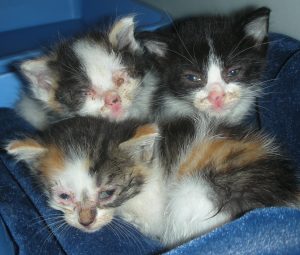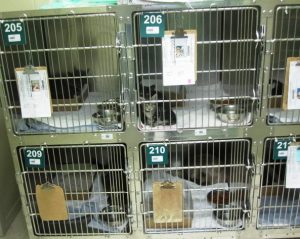Module 4: Healthcare practices for common contagious infectious diseases
Feline URI Treatment
In addition to treatment of dogs with CIRD, Dr. Wright decided that Gatorland Animal Services has the medical care staff, isolation housing, and medical care budget for treatment of cats with mild or moderate URI, but not those with severe URI requiring more intensive care and monitoring. She developed clinical criteria for defining mild, moderate, and severe URI taking into account the level of care for treatment of each category. The options for cats with severe URI include transfer to another facility for care or humane euthanasia if this is not available.

Similar to CIRD, most cases of Feline URI are caused by viruses (FHV and FCV), but there are important bacterial pathogens that initiate disease or cause secondary infections. The 2017 ISCAID Guidelines for Antimicrobial Treatment of Respiratory Tract Disease state that doxycycline is the best first-line antibiotic for empirical treatment of cats with URI. This antibiotic is effective for Bordetella bronchiseptica, Chlamydia felis, Strep zoo, and Mycoplasma felis infections.
Dr. Wright developed a protocol, checklist, and flowchart to assist her staff in diagnosis and treatment of feline URI.
The Key to Management of Feline URI
The most important key to Feline URI management is prevention, not treatment. Instead of focusing solely on how to treat cats with URI, shelter staff must address stressful environmental factors that cause URI, including crowding, long lengths of stay, improper housing, and lack of environmental enrichment to reduce stress. The most effective way to reduce stress in cats that must be admitted to the shelter is housing that supports the behavioral and welfare needs of cats. Several case studies have shown dramatic decreases in the Feline URI rates in shelters that provide proper housing for cats. Population management strategies that shorten each cat’s length of stay in the shelter should be followed, including removal of stray hold times and promoting fee-waived adoptions. Finally, the most ideal strategy is to prevent the admission of cats to shelters through kitten diversion programs, return-to-field programs for community cats, and providing services that support retention of cats in their homes.
Think About It…
Here are two shelters that admit similar numbers of cats each year.
- Shelter A
- Shelter B
Shelter A has 3 cat rooms, each containing banks of stainless steel cages that are usually full of cats. Each cage is single compartment and provides 4 square feet of floor space. The cages contain no hiding space or enrichment. The average length of stay for cats is 35 days. The live release rate for cats is 65% and the most common reason for euthanasia is “sick/URI” or “feral.”
Shelter B also has 3 cat rooms with banks of stainless steel cages. Each cat has 2 cages adjoined by a porthole providing double compartment housing with 8 square feet of floor space. The resting and eating area is in one side and the litterbox is in the other side. Each cat has a hiding box and a raised bed. The average length of stay is 21 days. The live release rate for cats is 90% and the most common reason for euthanasia is untreatable medical problems such as polytrauma.
Which shelter likely has the higher Feline URI rate? Should this shelter invest in:
- More housing in Isolation to accommodate treatment of cats with URI? [No]
- A bigger medical care budget to treat more cats? [No]
- Adding portholes to provide double compartment housing and enrichment in the cat rooms? [Yes! Providing more space, a hide box, and in-cage enrichment (toys) reduces stress]
- Seeking recommendations for reducing length of stay? [Absolutely! Should pursue strategies to keep cats and kittens out of the shelter, and strategies for quick release of those that must stay in the shelter]



